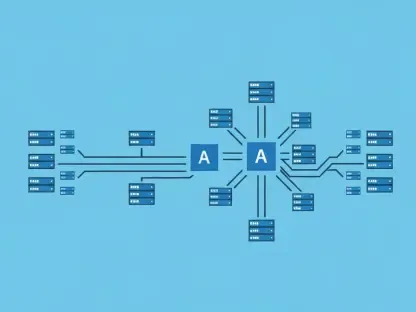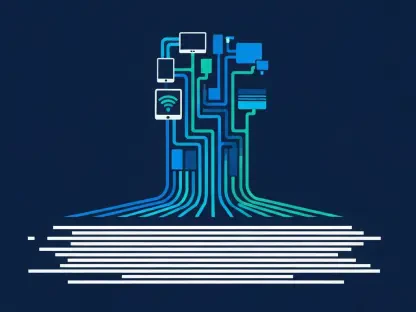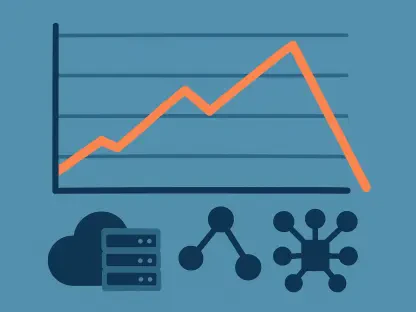Artificial Intelligence (AI) has transcended the realms of theoretical applications to become a pivotal force in enterprise software development. As organizations strive for efficiency and innovation, AI emerges as a key catalyst, driving productivity, process automation, and strategic growth. Among the frontrunners in leveraging AI-driven innovations is OutSystems, whose approach provides a compelling case study for the transformative power of AI in this domain.
Enhancing Developer Productivity with AI
Automating Intricate Tasks
AI is fundamentally changing how developers work by automating complex tasks that previously required significant manual effort. For instance, OutSystems’ implementation of a GenAI-driven customer support application illustrates this shift. This application autonomously resolves support queries, drastically reducing the workload on developers and allowing them to focus on more strategic tasks. The ability to handle these intricate tasks without human intervention not only quickens the resolution time for client issues but also enhances the overall customer experience.
By delegating mundane but necessary tasks to AI, developers can now prioritize solving high-level problems and crafting innovative solutions that drive the business forward. This automation enables a more balanced workload distribution, leading to increased job satisfaction among developers and a more streamlined development pipeline. The time saved from not managing repetitive tasks can be repurposed into strategic planning and execution, effectively improving both the quality and quantity of output from the development team.
Optimizing Workflows
Beyond automation, AI optimizes workflows, ensuring that developers can manage their time and resources more effectively. By streamlining routine processes, AI tools minimize interruptions and enhance overall efficiency, creating a more harmonious and productive development environment. Such optimizations are not simply about doing more with less; they pave the way for more intelligent allocation of human resources, which can significantly impact the bottom line.
For example, intelligent scheduling systems can analyze project timelines, team availability, and task dependencies to create optimal work schedules. These AI-driven systems can dynamically adjust to changes in real-time, such as unexpected delays or resource shortfalls, to maintain project timelines and budgets. Through continuous learning and adaptation, AI technologies can continually improve workflow efficiency, setting new performance benchmarks for the entire development team. Therefore, AI’s role in optimizing workflows goes beyond efficiency gains; it lays the foundation for sustainable and scalable growth.
AI-Driven Innovations by OutSystems
Introducing Mentor and AI Agent Builder
At the forefront of AI innovation, OutSystems has developed tools such as Mentor and the AI Agent Builder that showcase the potential of seamlessly integrating AI into the software development lifecycle. Mentor, previously known as Project Morpheus, leverages GenAI to accelerate code writing, automate repetitive tasks, and uphold quality and security standards, thus shaping the development process into a more streamlined and robust framework. These tools are designed to integrate deeply into the development lifecycle, ensuring that AI is not just an add-on but a core component of the development process.
The AI Agent Builder further enhances productivity by allowing developers to collaborate with AI agents designed to handle various aspects of software engineering, from initial coding to final debugging. This innovation allows human developers to focus on creative and problem-solving tasks, while AI agents manage more mechanical and time-consuming activities. These tools enable faster turnaround times for projects and higher quality outputs, all while maintaining rigorous security and compliance standards. By embedding AI so thoroughly into their development methodologies, OutSystems sets a precedent for other technology companies to follow in leveraging AI for greater innovation and efficiency.
Real-World Applications and Benefits
The practical applications of these AI tools are vast, offering tangible benefits that extend beyond mere productivity gains. By delegating routine and complex tasks to AI agents, developers can focus on higher-level activities, from creative coding to strategic decision-making, thereby fostering an environment where innovation can thrive. This shift not only boosts productivity but also allows for more thorough and creative problem-solving, ultimately leading to more innovative software solutions.
OutSystems’ innovations provide an inspiring model for how AI-driven tools can profoundly impact enterprise software development. These tools demonstrate that leveraging AI effectively can result in improved workflow efficiency, better quality assurance, and faster project turnaround times. The resulting productivity gains enable businesses to achieve more with their existing resources, thus creating a competitive edge in a rapidly evolving market. Moreover, the ability to maintain high standards of security and quality through AI ensures that these innovations are both sustainable and scalable, offering long-term benefits for companies that decide to adopt such technologies.
Leveraging GenAI for Lifecycle Optimization
Transforming Software Development Lifecycles
AI’s role in transforming the software development lifecycle cannot be overstated. GenAI can significantly shorten project timelines and improve system architectures. However, to achieve these benefits, organizations must first establish the necessary infrastructure—a scalable platform and clean datasets are essential prerequisites. Without these foundational elements, the implementation of AI can result in fragmented solutions that fail to deliver anticipated efficiencies and improvements.
Implementing GenAI effectively requires substantial initial investment in technology and training, but the long-term gains far outweigh these upfront costs. Robust infrastructure allows for the integration of AI at every stage of the software development lifecycle, from planning and design to testing and deployment. This holistic approach ensures that each phase benefits from AI’s predictive analytics, automated workflows, and continuous improvement capabilities. The end result is a development process that is not only faster but also far more adaptable to changing requirements and emerging technologies.
Integration and Alignment
For AI to fully optimize the development lifecycle, it must be seamlessly integrated within existing processes and aligned with company goals. This alignment ensures that AI-driven initiatives are in sync with strategic objectives, leading to more coherent and effective outcomes. Failure to align AI with broader business goals can lead to underutilized technologies and missed opportunities for innovation, effectively negating the potential benefits AI offers.
A well-integrated AI system can continually analyze project performance against strategic KPIs, providing real-time insights and recommendations for improvement. This real-time feedback allows organizations to adapt quickly, making data-driven decisions that keep projects on course and aligned with business priorities. Additionally, a clear alignment between AI initiatives and company goals enhances stakeholder buy-in, facilitating smoother transitions and broader acceptance of AI-driven changes across the organization. Hence, the ultimate goal is not just to implement AI but to embed it so deeply into the development processes that it becomes an intrinsic component of the organization’s strategy and operations.
Overcoming Challenges in AI Adoption
Dealing with Legacy Systems
One of the most significant hurdles in AI adoption is the presence of legacy systems, which often hinder flexibility and innovation. These outdated systems can create bottlenecks, making it challenging to implement new technologies effectively. OutSystems’ transition to a services-based architecture serves as a model solution, demonstrating how such challenges can be overcome. By moving away from monolithic architectures to microservices, companies can achieve greater agility and adaptability, setting the stage for successful AI integration.
Legacy systems often rely on older technologies that are not compatible with modern AI solutions, necessitating substantial overhauls or replacements. This transition can be resource-intensive, requiring both time and financial investment. However, the benefits of making this shift are manifold, ranging from increased system flexibility to enhanced scalability and security. Through careful planning and phased implementation, organizations can mitigate disruptions while steadily moving toward a more AI-compatible infrastructure. Thus, overcoming the inertia of legacy systems is not just a technical challenge but a strategic imperative for businesses aiming to stay competitive.
Phased Approach to Implementation
Adopting a phased approach—starting small and scaling fast—helps organizations gradually implement AI solutions without overwhelming their existing structures. This incremental adoption allows for adjustments and improvements over time, fostering a smoother transition to AI-driven processes. By initially focusing on specific areas with high potential for AI-driven improvements, businesses can generate quick wins that build momentum and support for broader AI integration.
This approach also allows organizations to pilot AI technologies in controlled environments, learn from initial deployments, and refine their strategies before scaling up. This iterative process of testing, learning, and improving ensures that AI solutions are both effective and sustainable when fully implemented. It reduces the risks associated with large-scale deployments and provides valuable insights that can be applied to future AI initiatives. In essence, a phased approach balances ambition with pragmatism, enabling companies to make steady progress while minimizing disruption and maximizing the impact of AI on their enterprise software development processes.
AI in Managing Complex Projects
Automating Routine Project Management Tasks
In the realm of project management, AI can automate routine tasks, thereby enhancing efficiency and accuracy. Through data analysis and real-time insights, AI solutions provide project managers with the information needed to make informed decisions swiftly. Automating these routine tasks reduces the administrative burden on project managers, allowing them to focus on more strategic activities such as resource allocation, risk management, and stakeholder communication.
One of the primary advantages of AI in project management is its ability to monitor and analyze vast amounts of data in real-time. This capability allows for proactive identification of potential issues before they escalate, enabling timely interventions that can save both time and resources. AI-driven tools can also predict project outcomes based on historical data, offering valuable foresight that aids in planning and decision-making. By leveraging AI, project managers can achieve higher levels of efficiency and effectiveness, ultimately leading to more successful project outcomes.
Risk Prediction and Resource Optimization
AI’s capabilities extend to risk prediction and resource optimization, crucial elements in managing complex projects. By analyzing data patterns and forecasting potential issues, AI tools help prevent delays and cost overruns. This proactive approach ensures that projects are not only completed on time but also align with strategic goals. AI-driven risk prediction models can identify potential bottlenecks, resource shortfalls, and other risks, allowing project managers to take preemptive actions to mitigate these issues.
Moreover, AI can optimize resource allocation by analyzing project requirements and available resources to create the most efficient utilization plans. This ensures that resources are used effectively, reducing waste and enhancing productivity. AI-driven optimization models can also dynamically adjust resource plans in response to changing project conditions, ensuring that the project remains on track even when faced with unexpected challenges. By combining risk prediction and resource optimization, AI empowers project managers with the tools they need to deliver complex projects successfully, meeting both time and budget constraints while achieving strategic objectives.
Building the Future with AI-Driven Development
Enhancing Collaboration and Skill Development
AI’s potential to enhance team collaboration and foster specialized skill development is widely recognized. By freeing up human resources from routine tasks, AI allows teams to focus on creative and complex problem-solving activities. This shift not only boosts team morale but also drives sustained innovation. AI-driven collaboration tools can facilitate better communication, coordination, and workflow management among team members, enabling more efficient and effective teamwork.
Furthermore, AI can support continuous skill development by providing personalized learning and development opportunities. AI-driven analytics can identify skill gaps and recommend targeted training programs to help team members improve their competencies. This ongoing skill enhancement ensures that the development team remains at the cutting edge of technology, driving sustained innovation and improvement. By enhancing both collaboration and skill development, AI creates an environment where teams can excel, delivering high-quality software solutions that meet and exceed business objectives.
The Importance of Robust Infrastructure
Artificial Intelligence (AI) has moved beyond theoretical discussions to become a crucial element in the field of enterprise software development. Today, businesses seeking to improve their efficiency and drive innovation are turning to AI as a key enabler. This technology is instrumental in enhancing productivity, automating complex processes, and fostering strategic growth within organizations.
A prime example of AI’s transformational potential in this arena can be seen through the efforts of OutSystems. Not only have they embraced AI to enhance their software development processes, but they also provide a compelling case study on how AI can fundamentally alter the landscape of enterprise solutions. OutSystems demonstrates how AI can streamline development, reduce time-to-market for new products, and enable more agile responses to business needs. Their AI-driven approach serves as a benchmark for other organizations looking to harness the power of AI to achieve similar transformative results.
With the implementation of AI, OutSystems exemplifies how technology can act as a pivotal force in overcoming traditional limitations in software development. By incorporating AI into their systems, they are able to automate repetitive tasks, allow for more accurate data analysis, and provide better customer experiences. This, in turn, not only enhances the overall efficiency but also creates a more innovative business environment conducive to growth and success.









